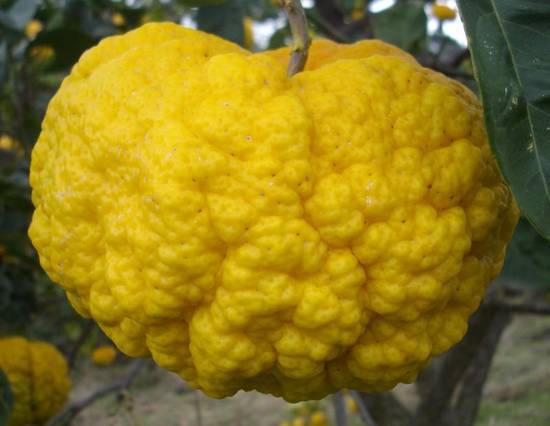
Pompia Fruit
This post is also available in:
 Italiano (Italian)
Italiano (Italian)
“Sa Pompia”, or Citrus monstruosa, is a fruit with a thick, rough and ragged skin.
Its origin is not known and there’s no evidence about anybody importing it to Sinicola or simply discovering it as an ecotype.
Cultivated since ancient times, a single specimen can weigh up to 24.69 oz.
In Siniscola, “Sa pompia” has survived mostly thanks to a popular dessert whose recipe has been handed down orally over the centuries.
Text source: http://www.siniscolaonline.it/pompia.htm
The pompia tree looks like an orange one, but the branches are quite thorny. The fruits are very strange-looking and even bigger than grapefruits – they can weigh up to 24.69 oz. They appear intense yellow and with a thick, grainy skin. Each specimen looks like the result of some unsuccessful biogenetics experiment, but that’s not the case as pompia has already existed for over two centuries. It grows only in Sardinia, in an area of Baronia, around the municipality of Siniscola.
Pompia trees grow spontaneously in scrubs and citrus groves. The peel is used to make liqueurs, while the white part underneath is a vital ingredient for “aranzata”, a traditional Sardinian dessert prepared with candied orange peel, honey and almonds: the pulp and its juice are too acidic, much more than lemon, and cannot be, nor eaten at all.
Some people think that pompia is a kind of cedar, although there are very few features in common between the two species. Most likely, it is a natural hybrid developed among local citrus fruits.
The territory of Siniscola is part of the Sardinian citrus area that stretches from Budoni to Orosei, where many varieties of cedar, orange and lemon trees have been grown over the centuries.
Official agronomy compendiums of the XVIII century (in particular, an essay on local plant and animal biodiversity by Andrea Manca dell’Arca, published in 1780), mentioned pompia for the first time in history. In 1760, an official statistical survey also mentioned some cultivations of pompia in Milis, around the town of Oristano.
Desserts made with pompia are quite elaborate: six hours must pass after the initial peeling, before boiling the carefully scraped skin (and the white part underneath) and dipping it into honey; the result is then placed in a pan to simmer for about three hours, and at the end of this process, it is cooled and placed on a saucer: “sa pompìa intrea” is ready!
When filled with ground almonds, it’s called “sa pompìa prena”.
“S’aranzata” dessert is also prepared with candied pompia: it’s basically a cake made with pieces of this fruit, almonds, wildflower honey, and small coloured sprinkles (“sa trazea”).
Text source: https://www.fondazioneslowfood.com/it/presidi-slow-food/pompia/
The two pictures are taken from:
http://larancia.org/i-segreti-della-pompia-da-un-mostruoso-agrume-sardo-lelisir-della-salute/
This post is also available in:
 Italiano (Italian)
Italiano (Italian)
Contatti
08029 Siniscola()
